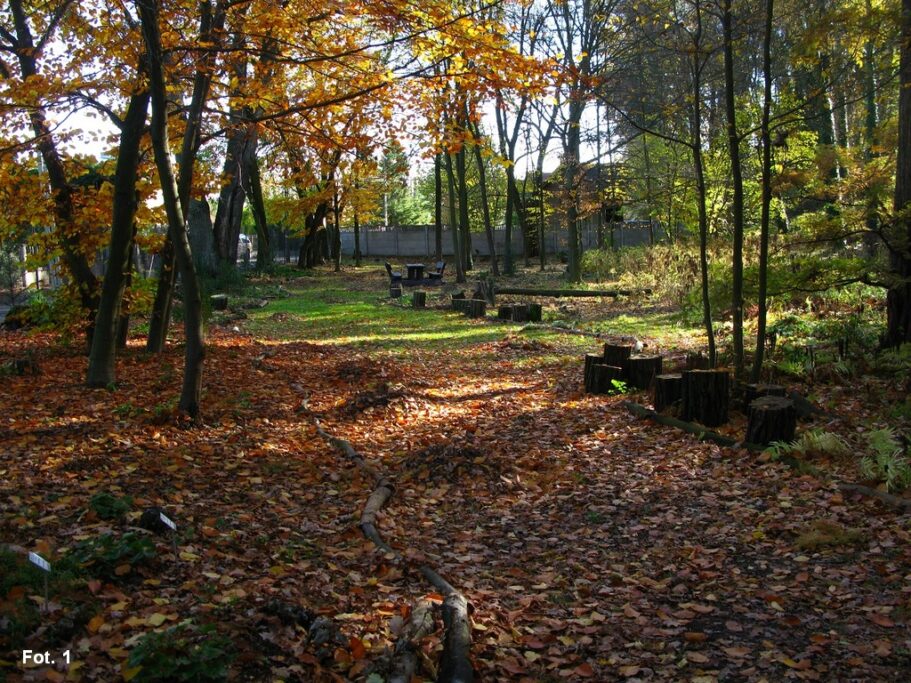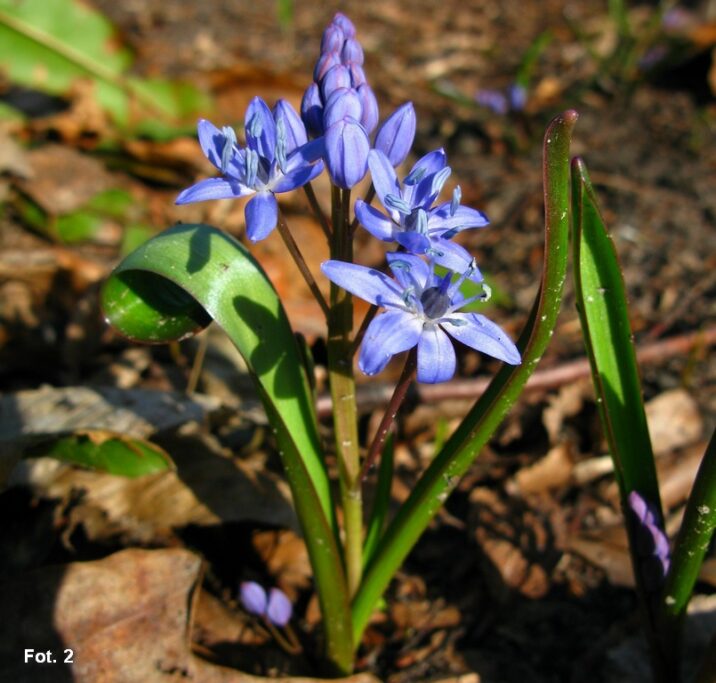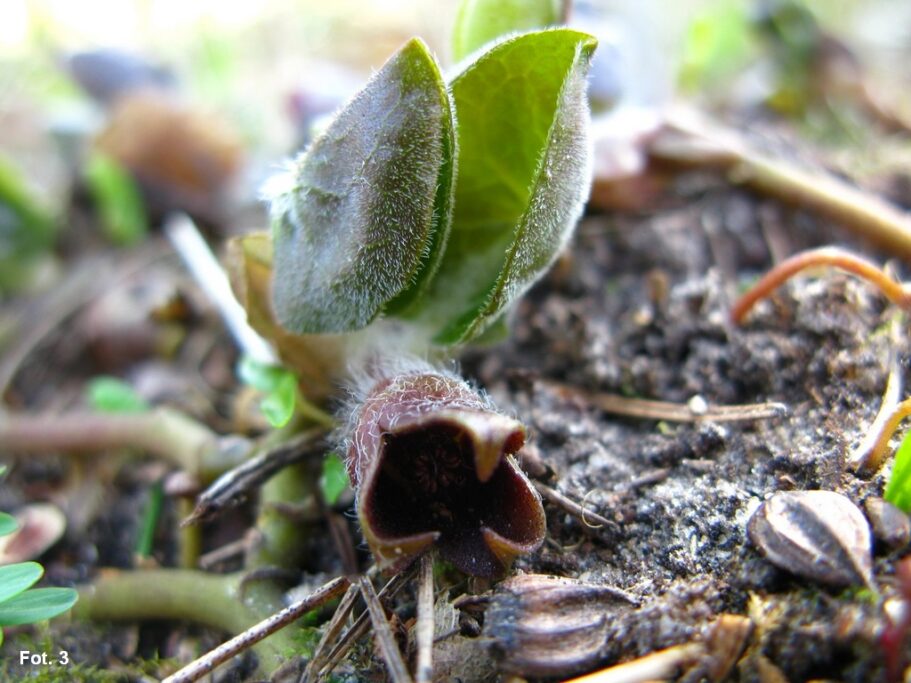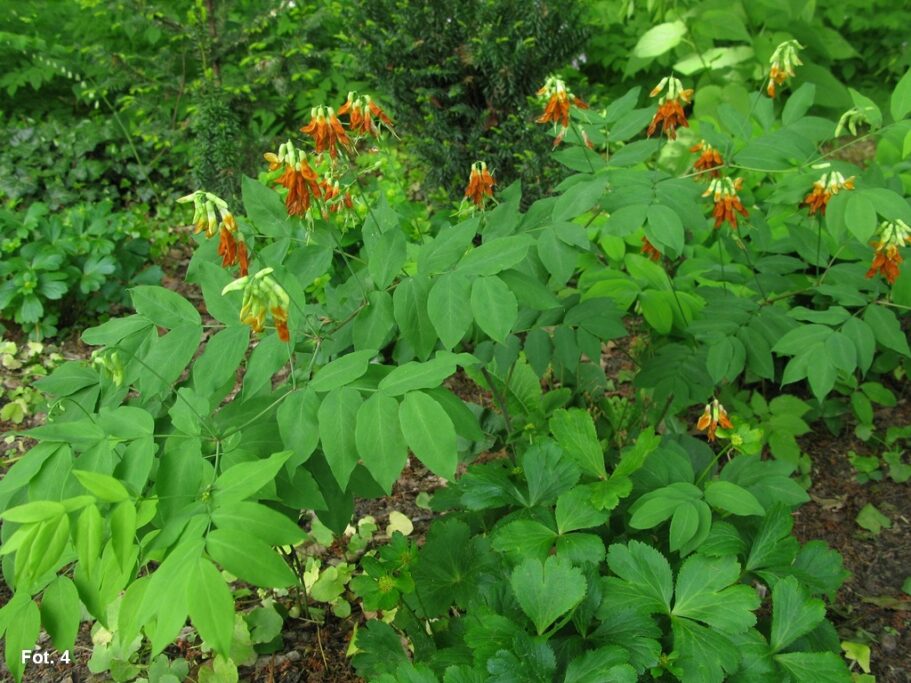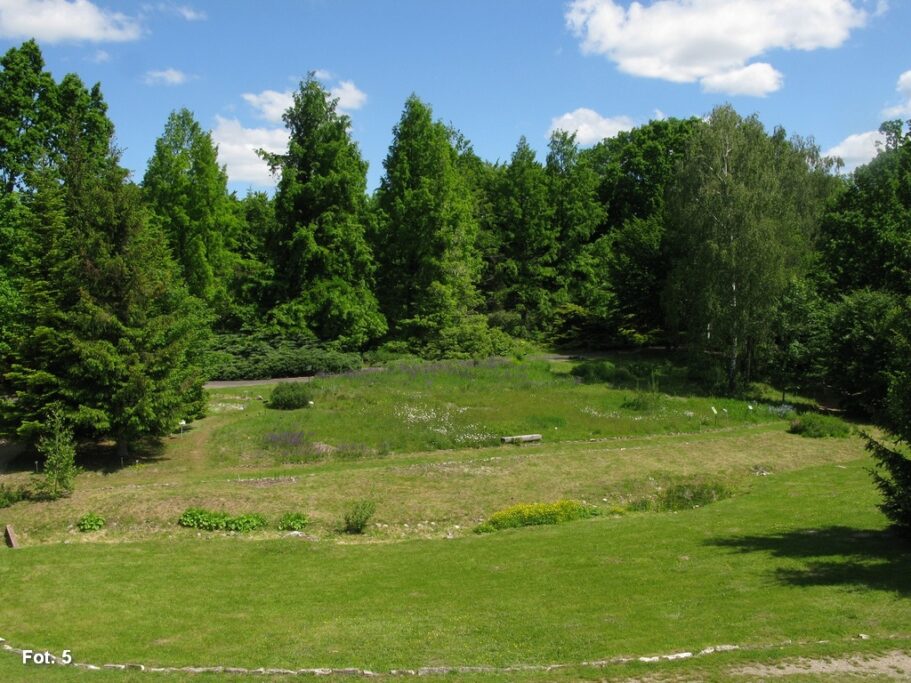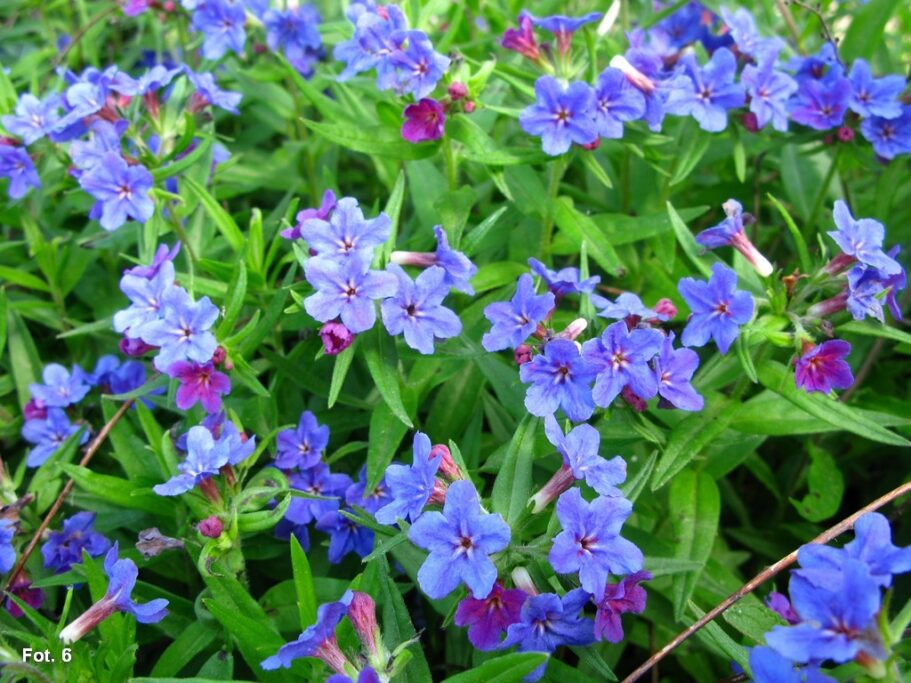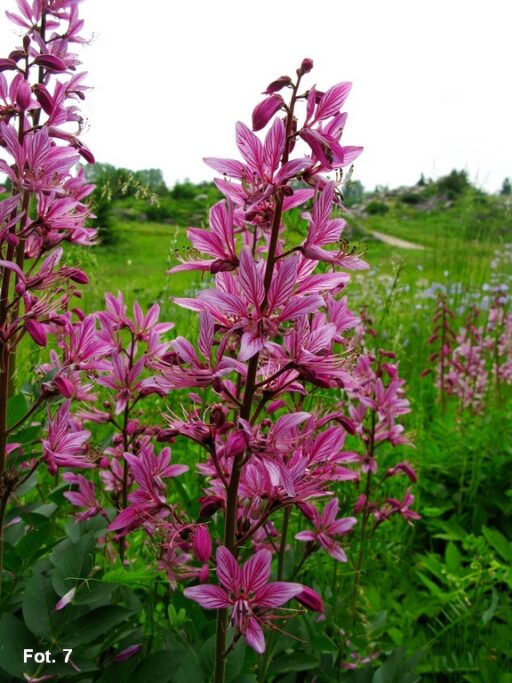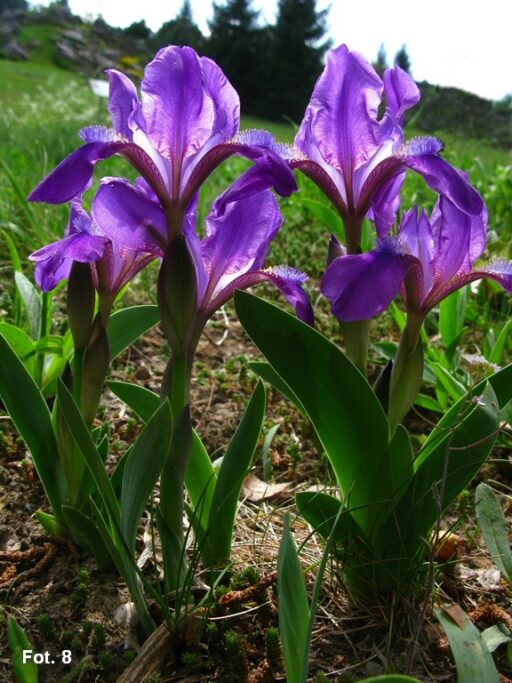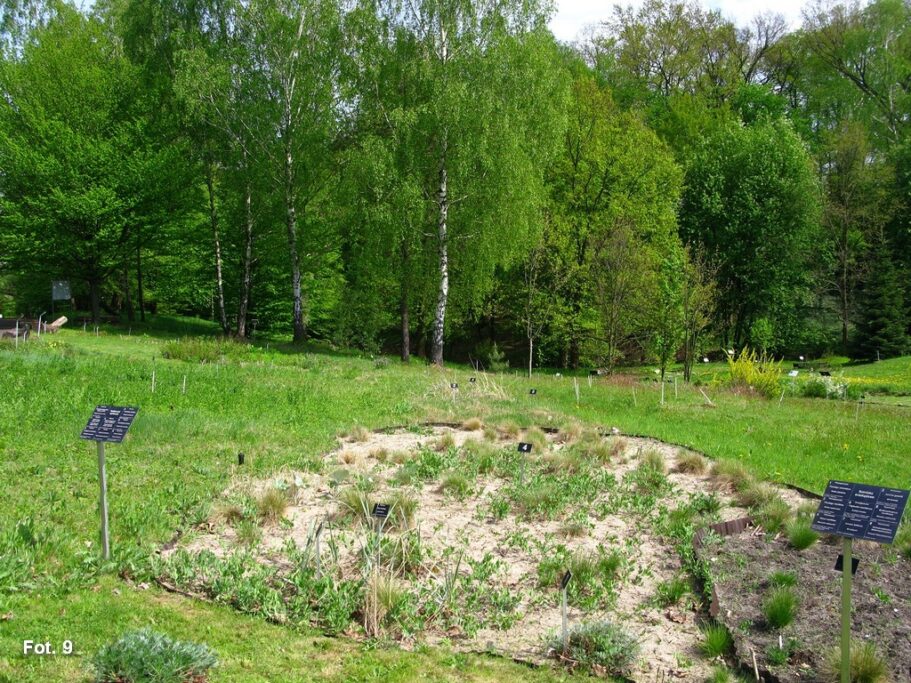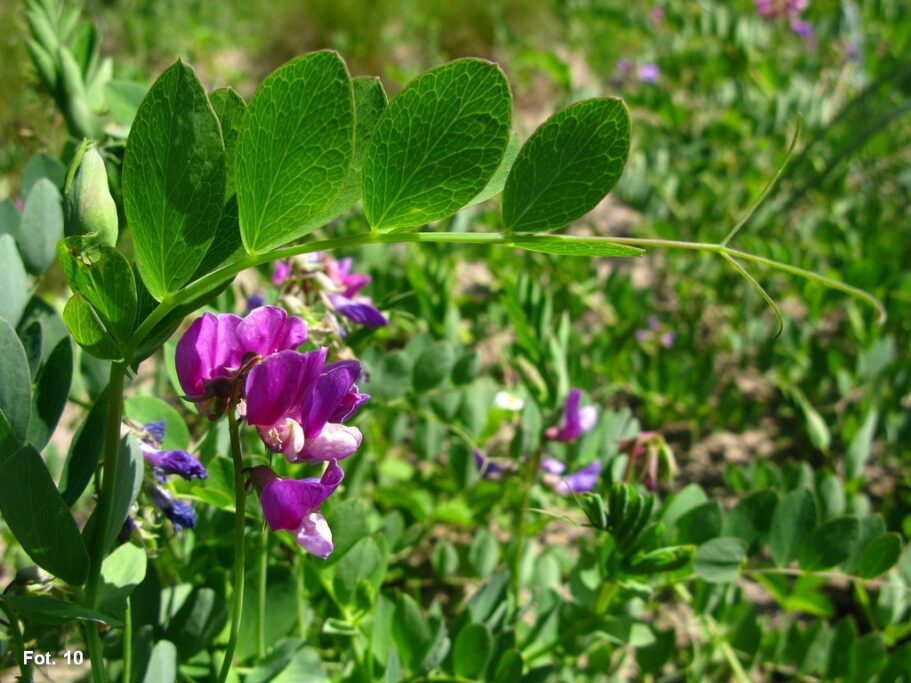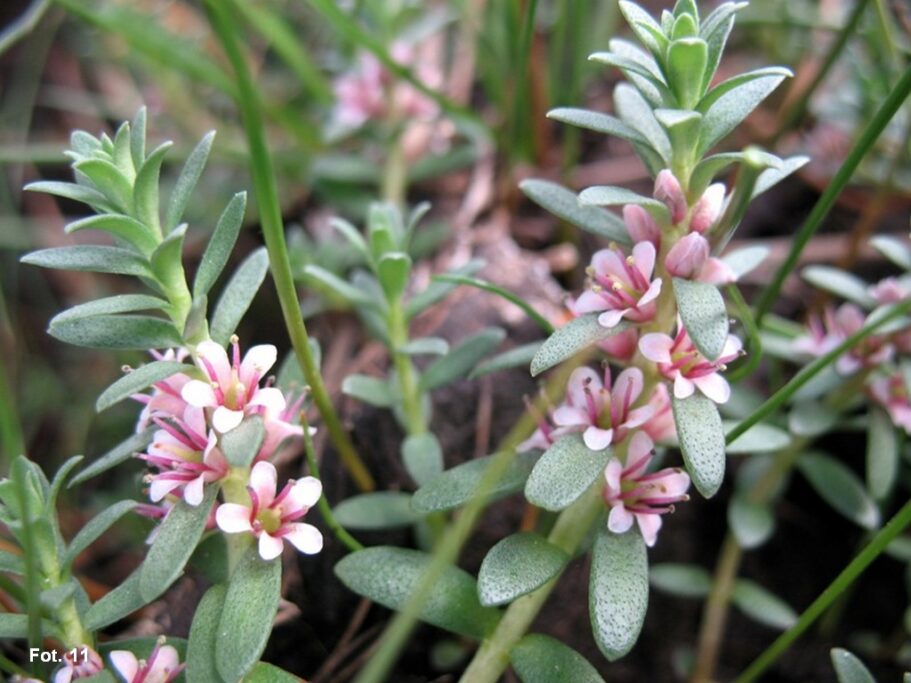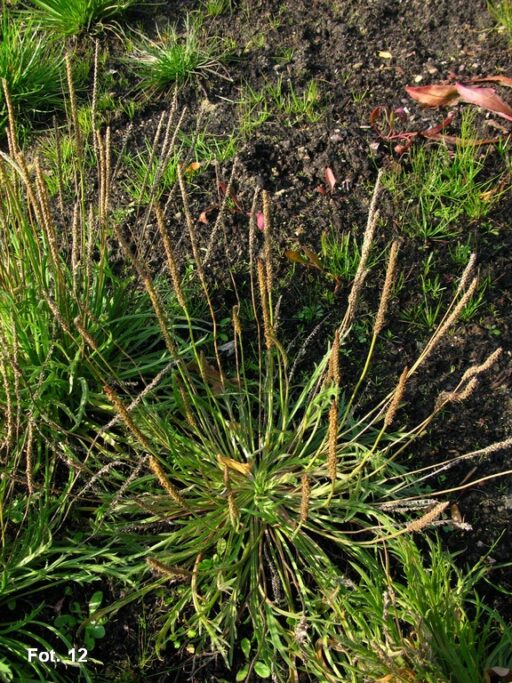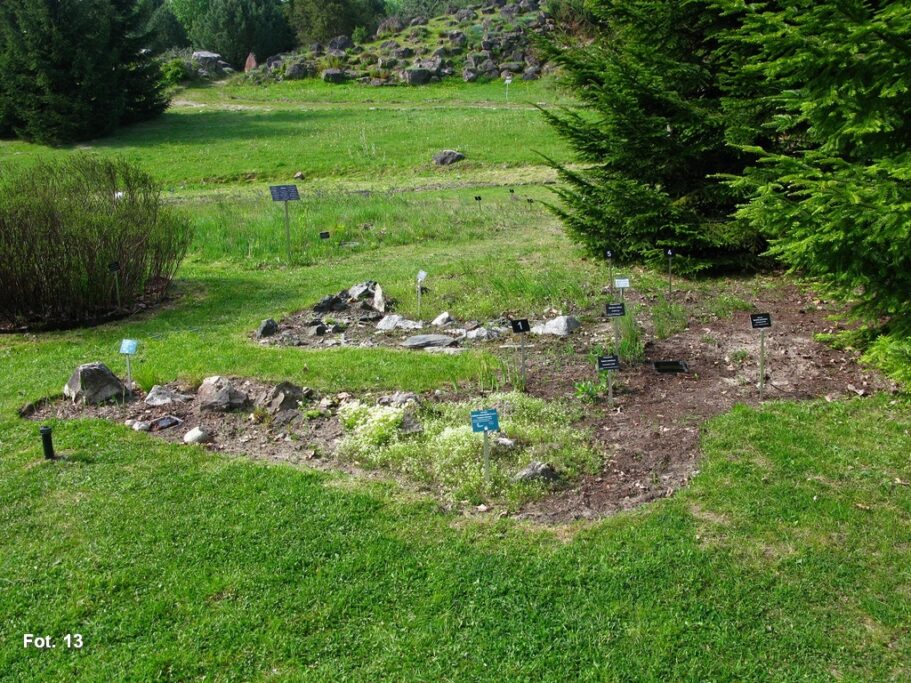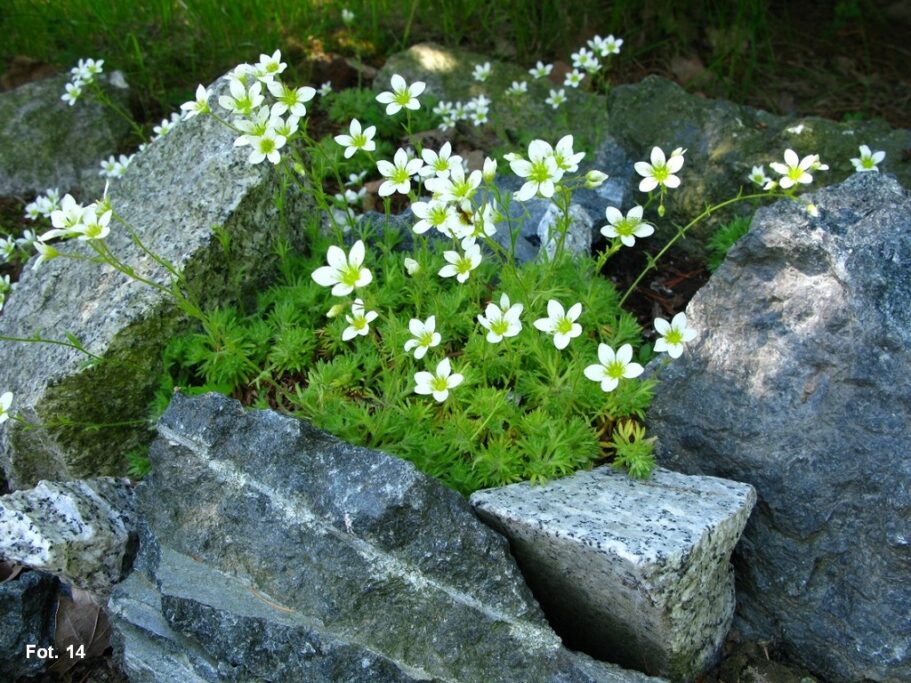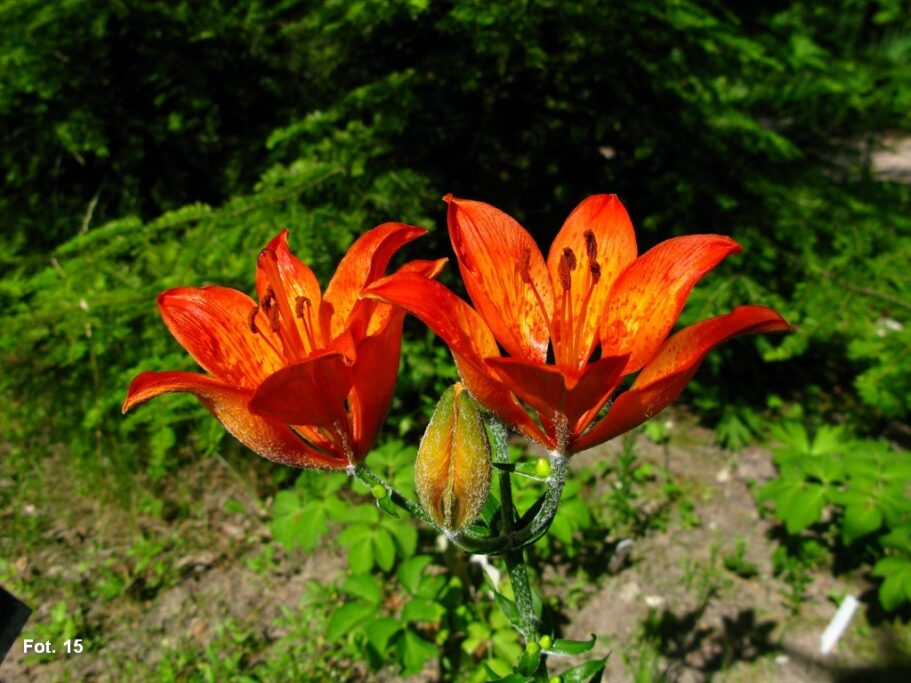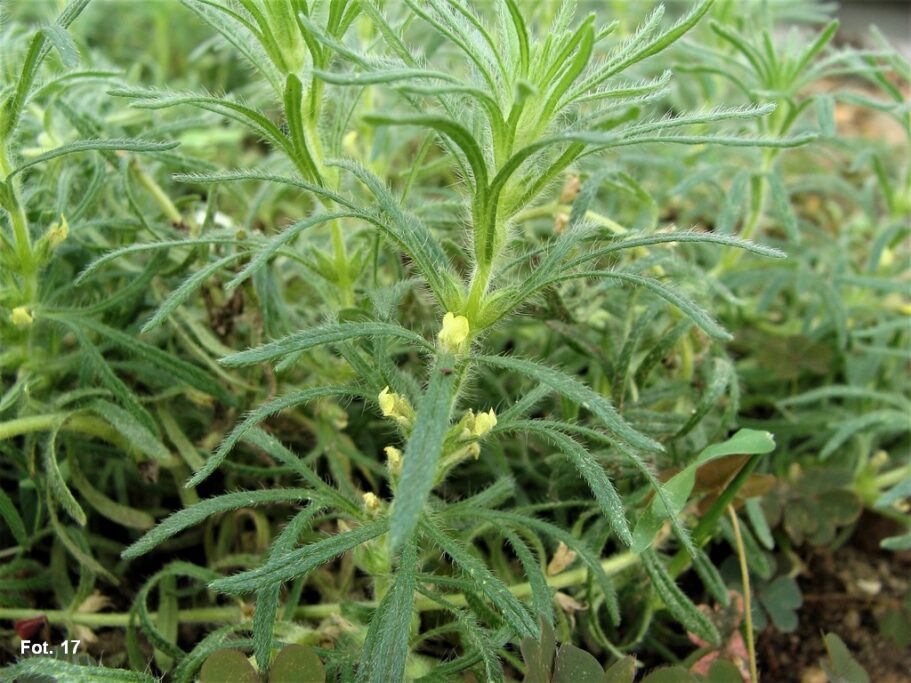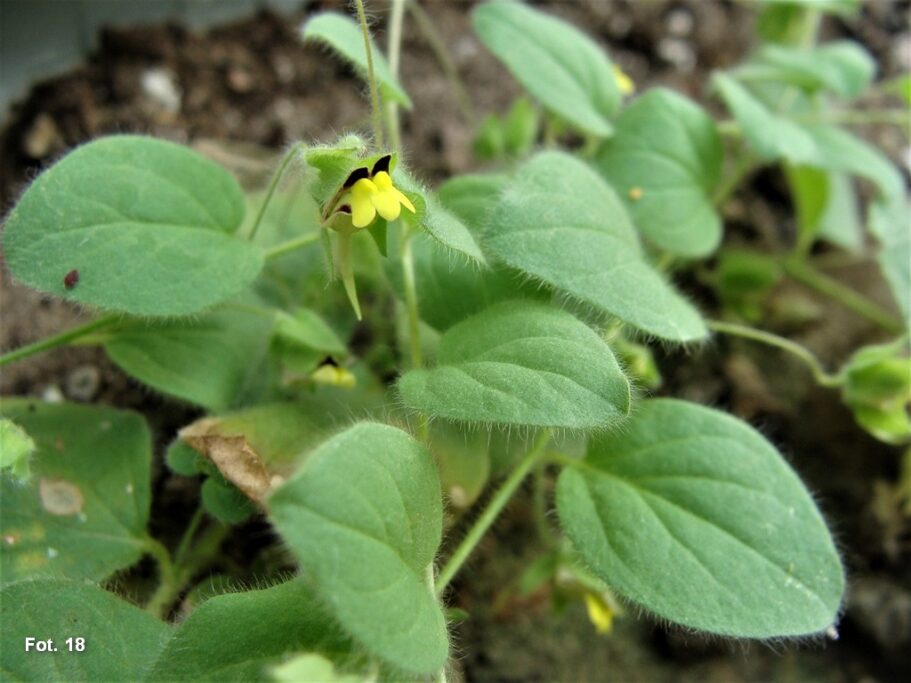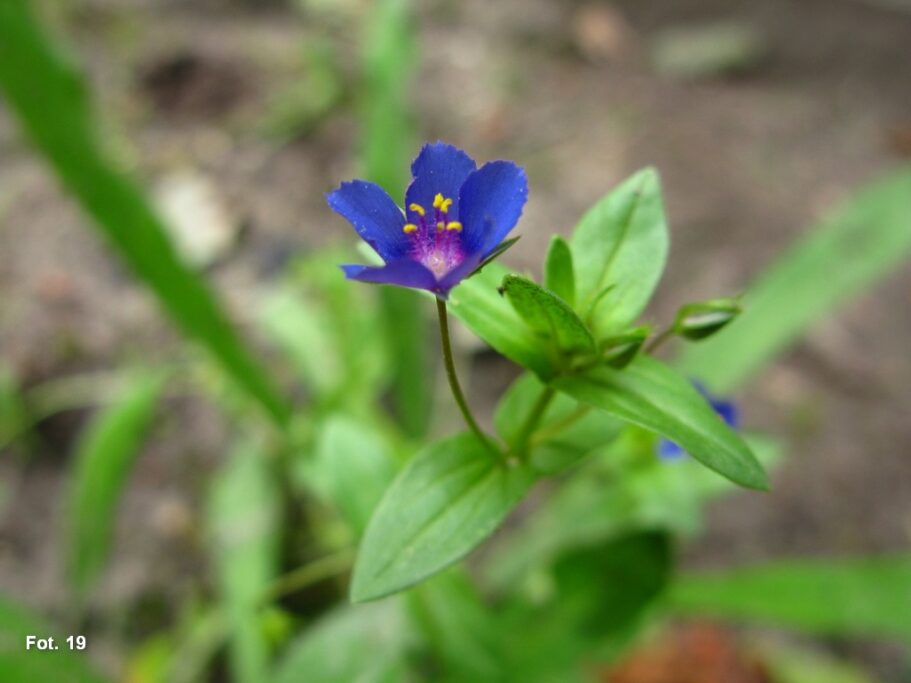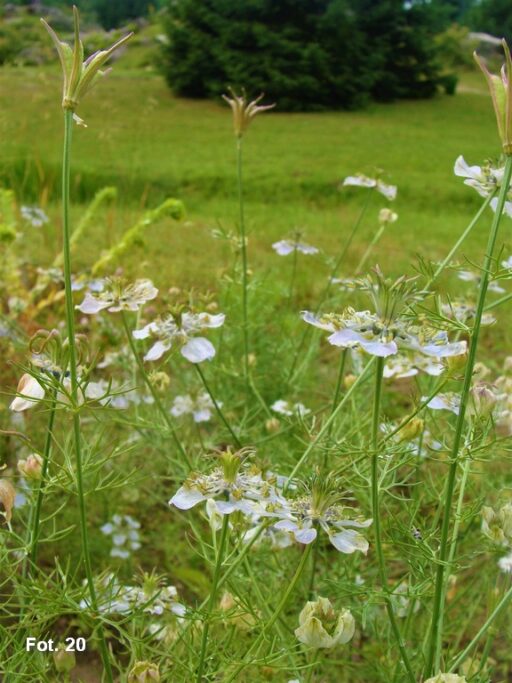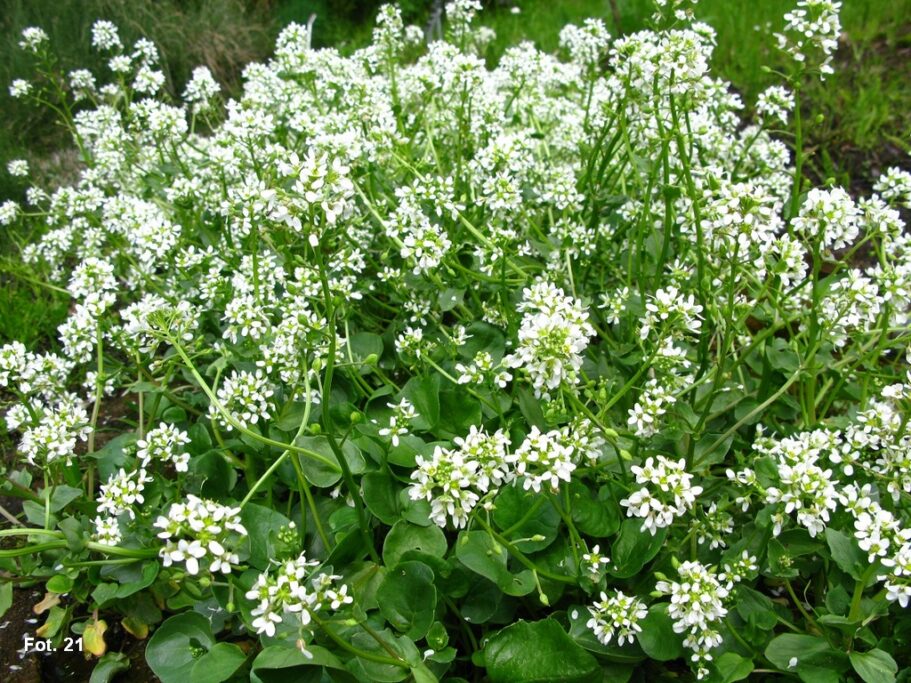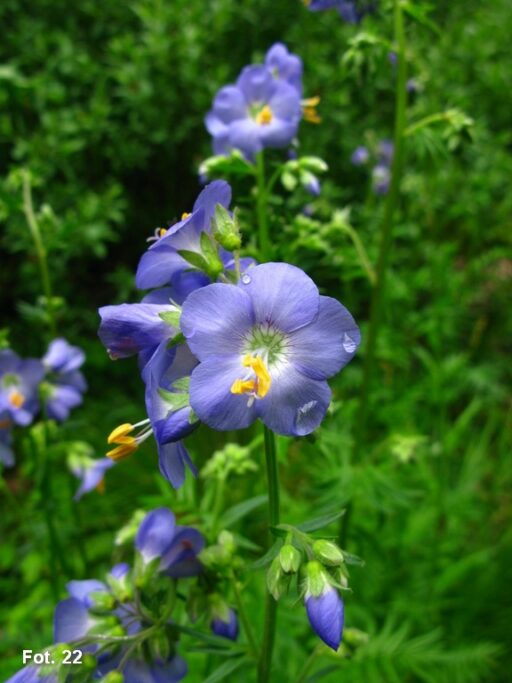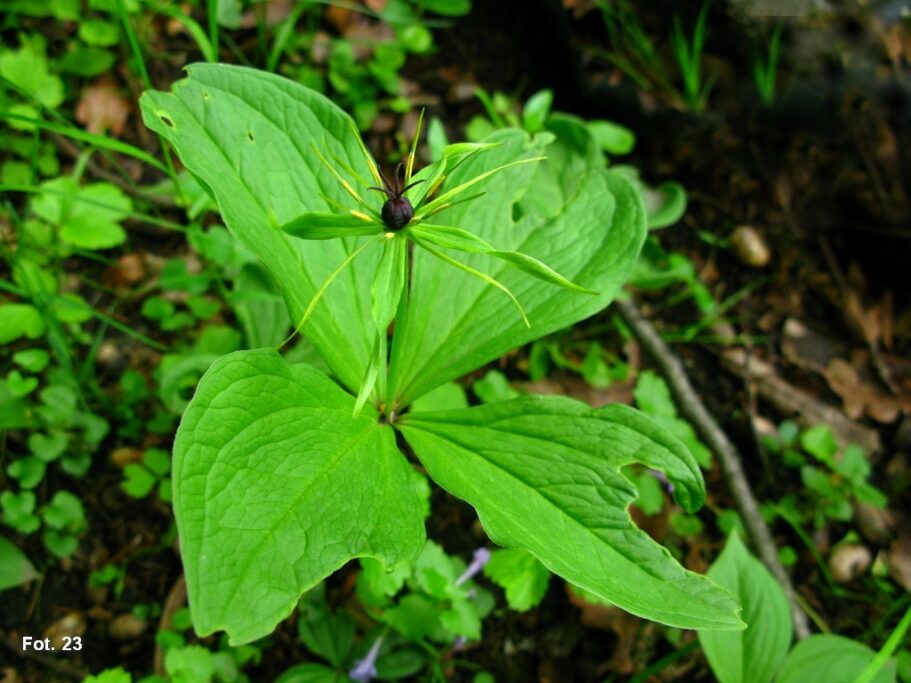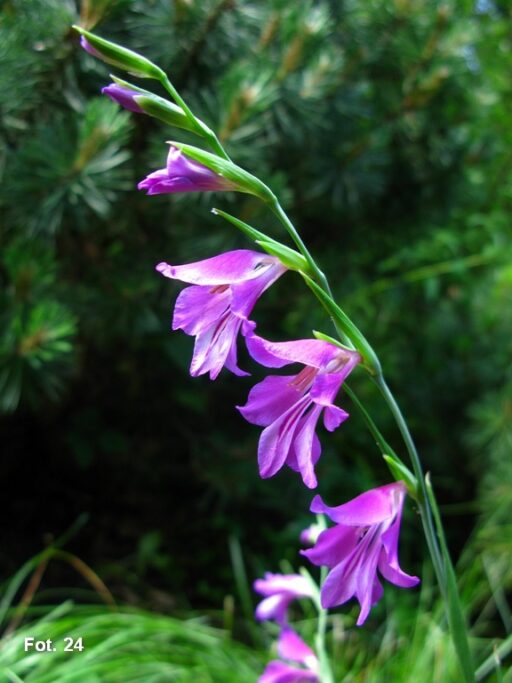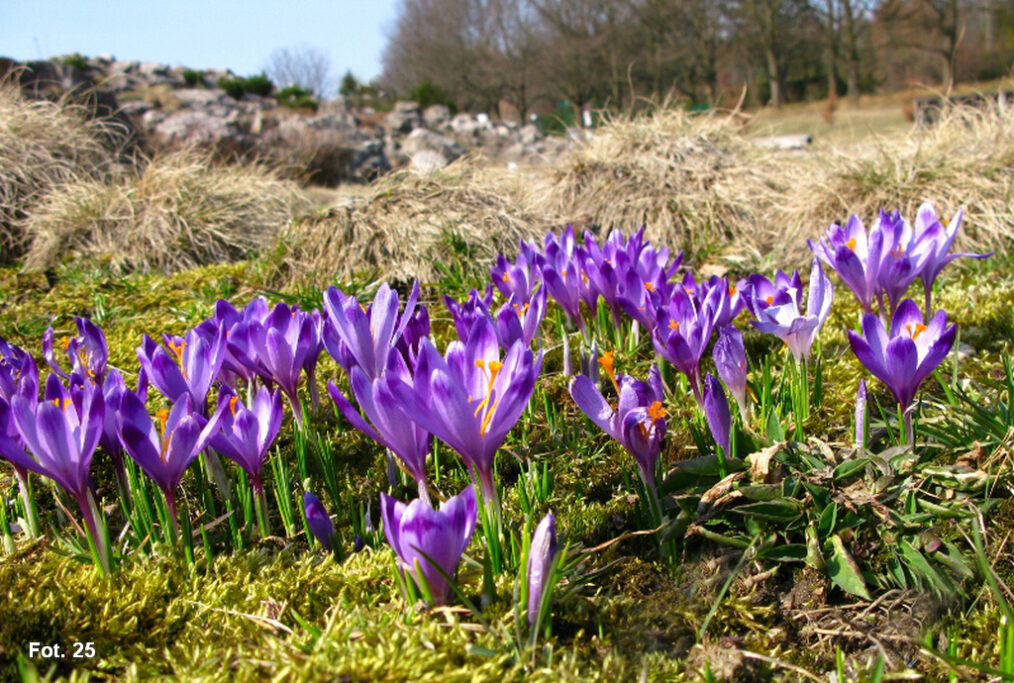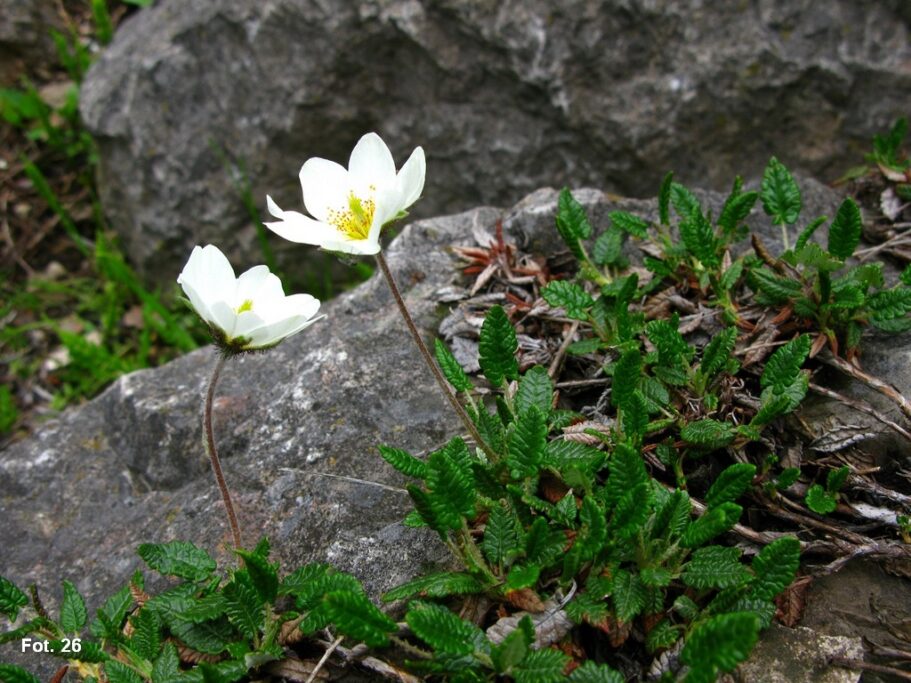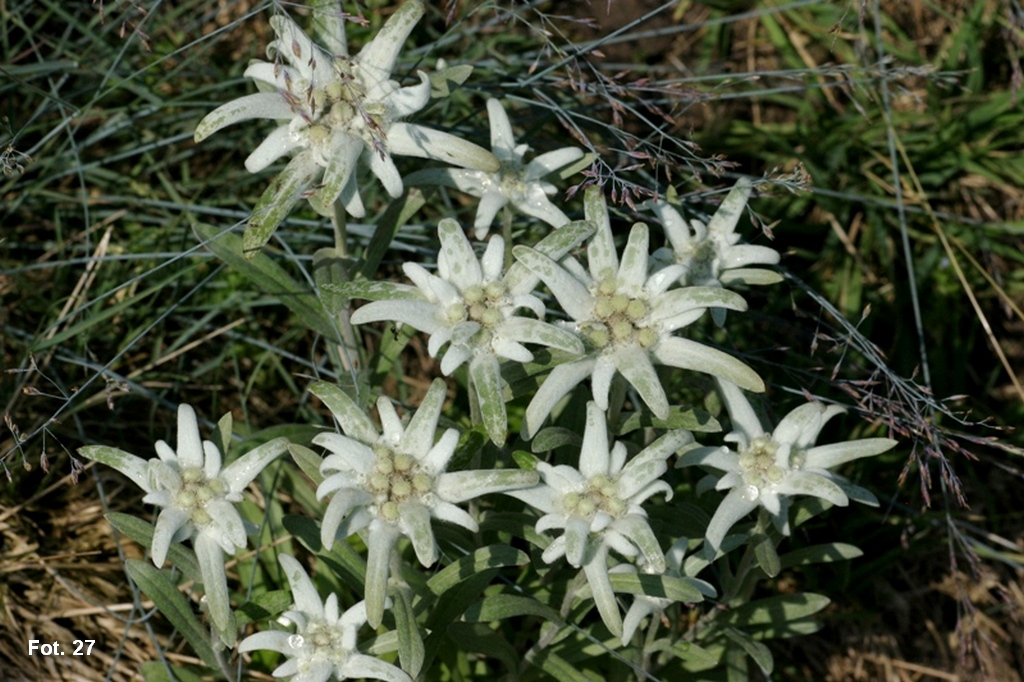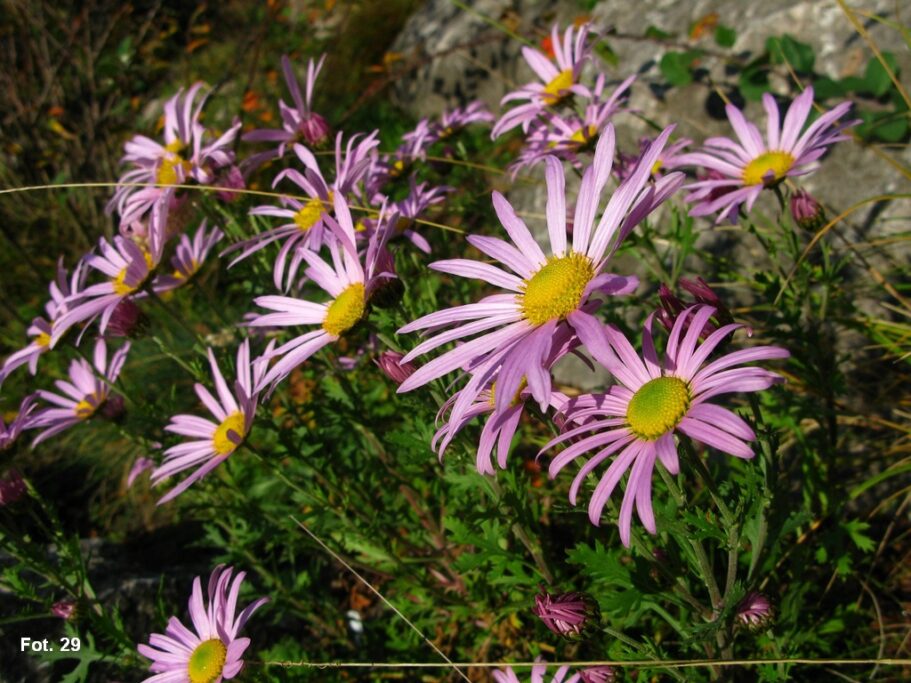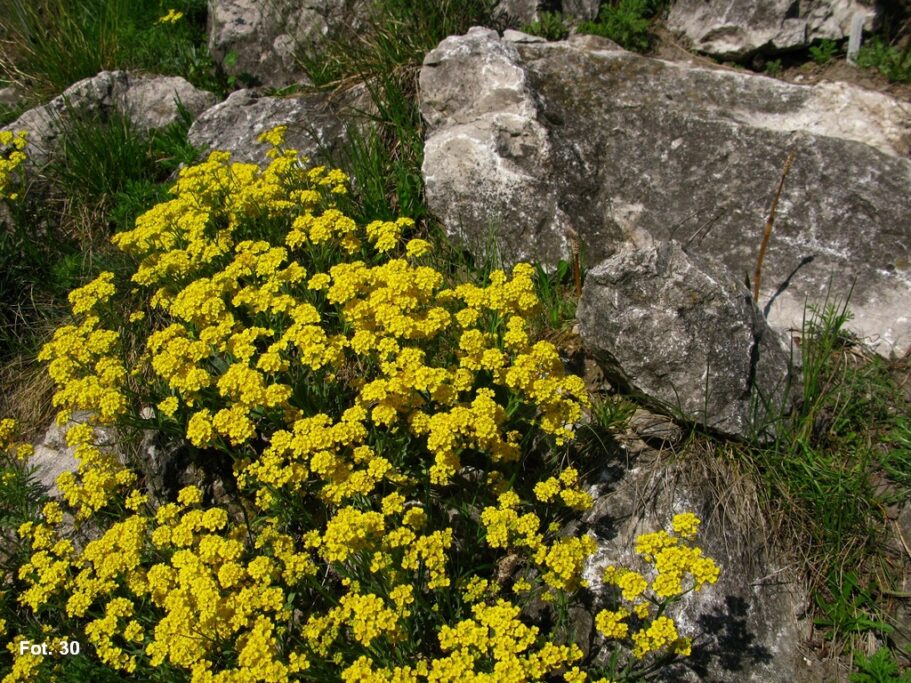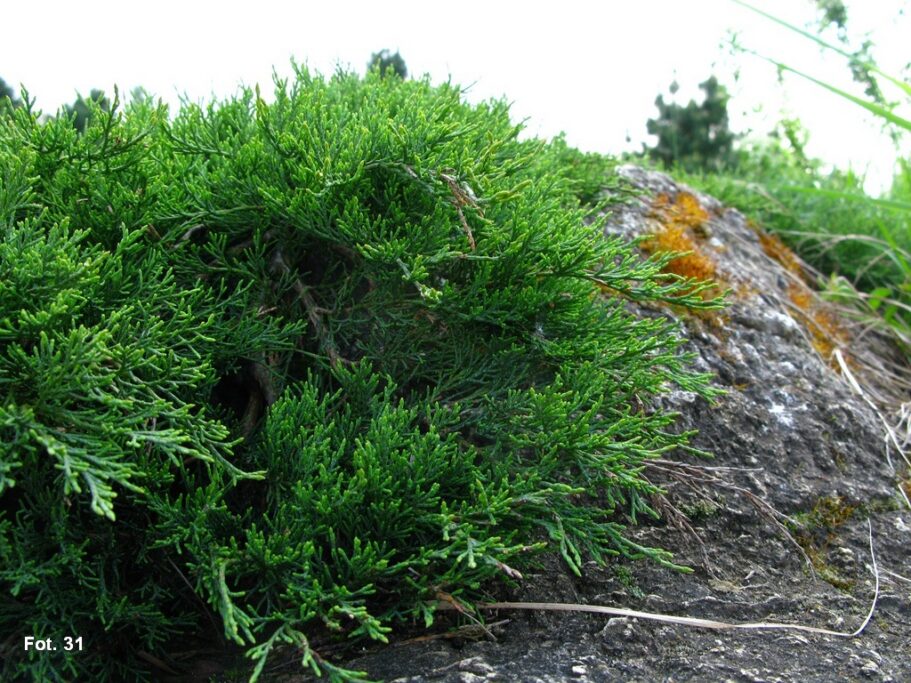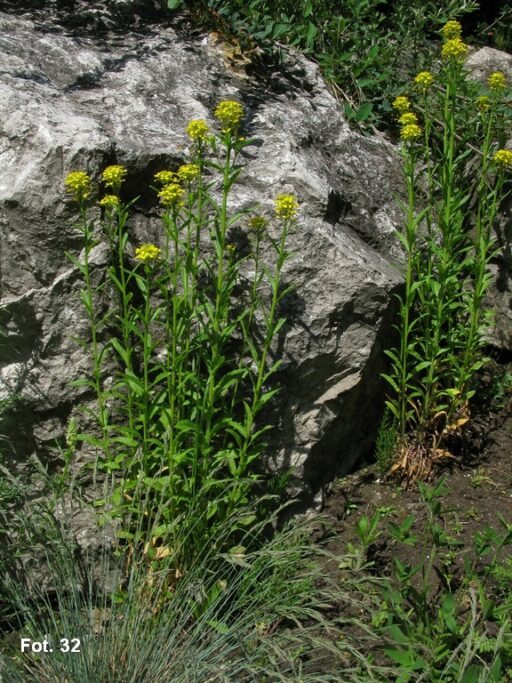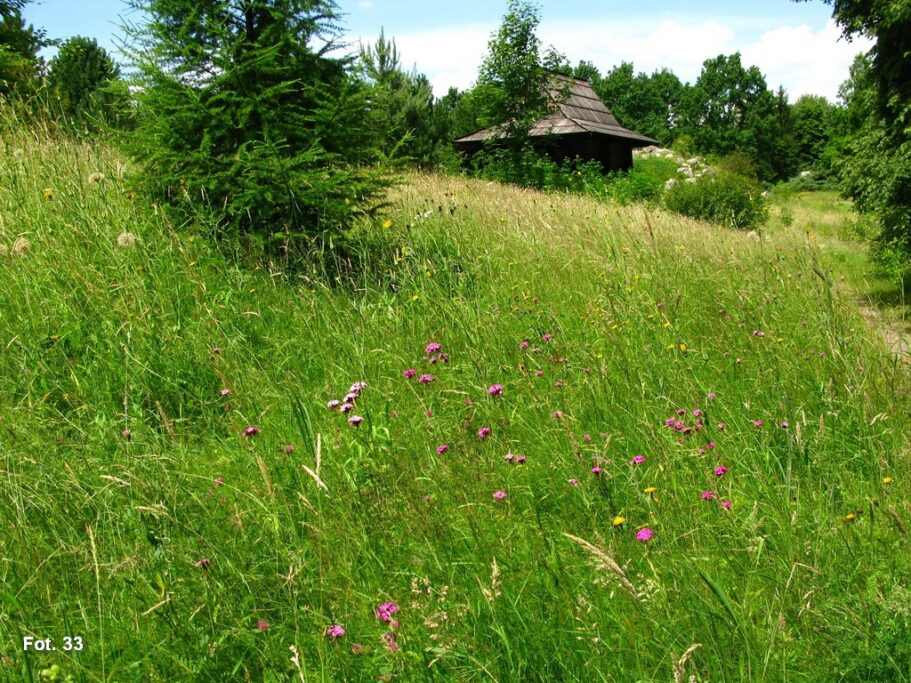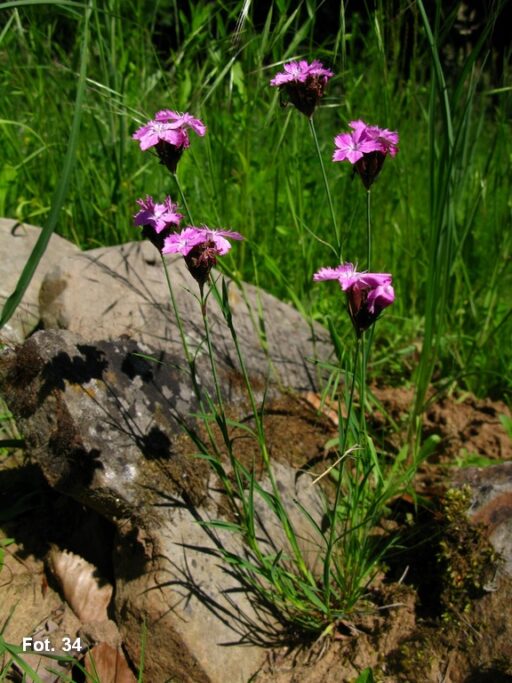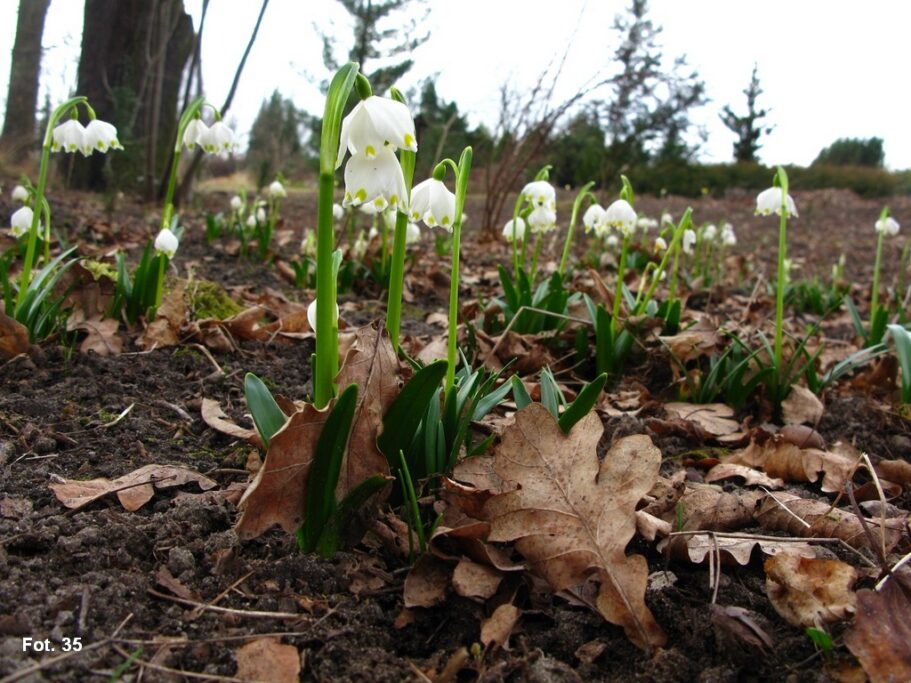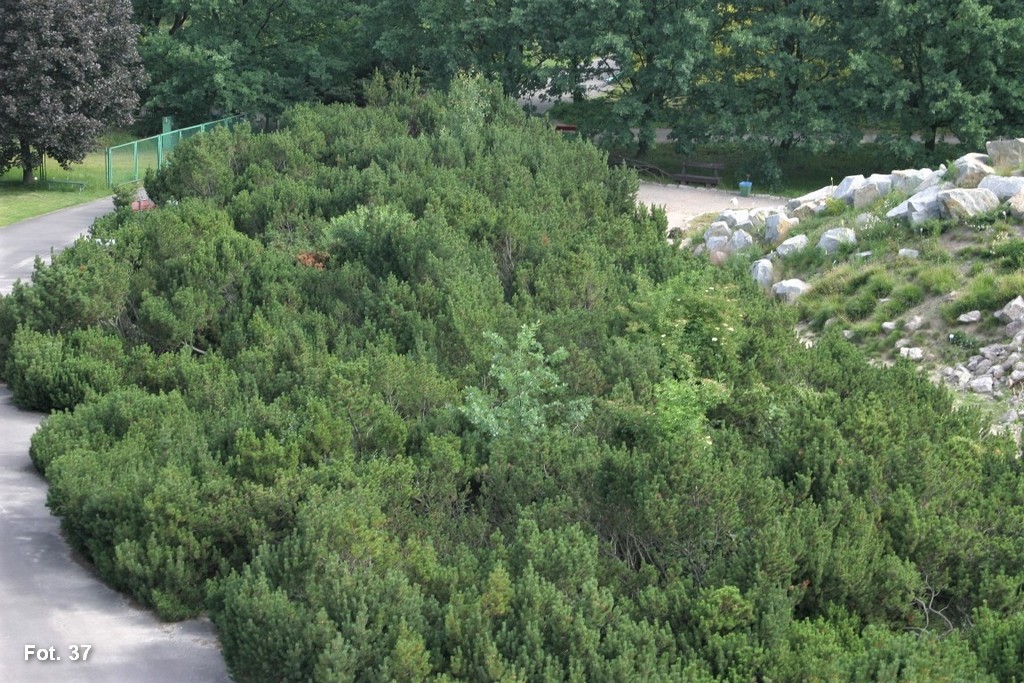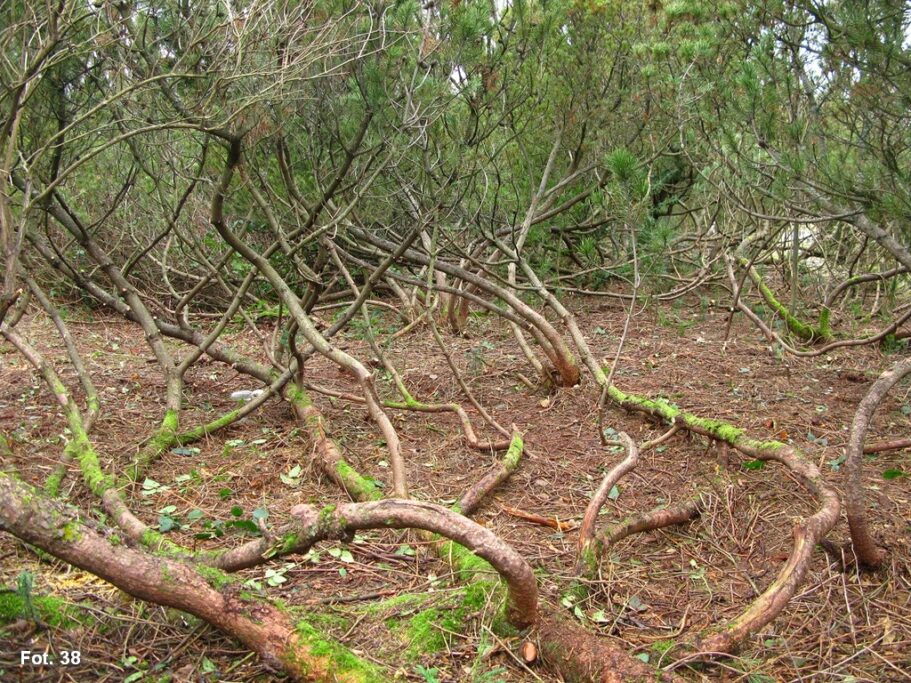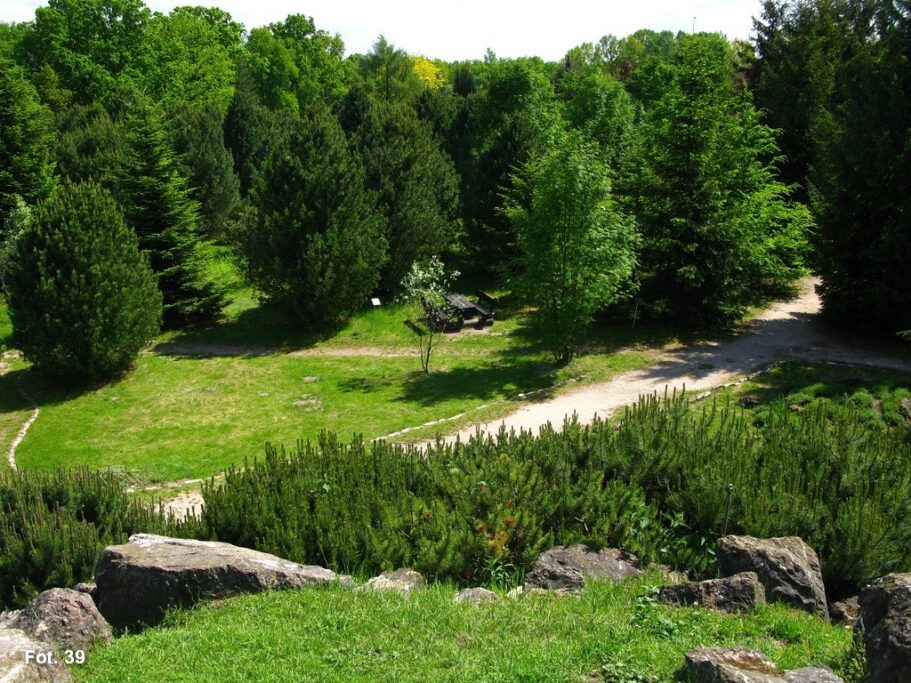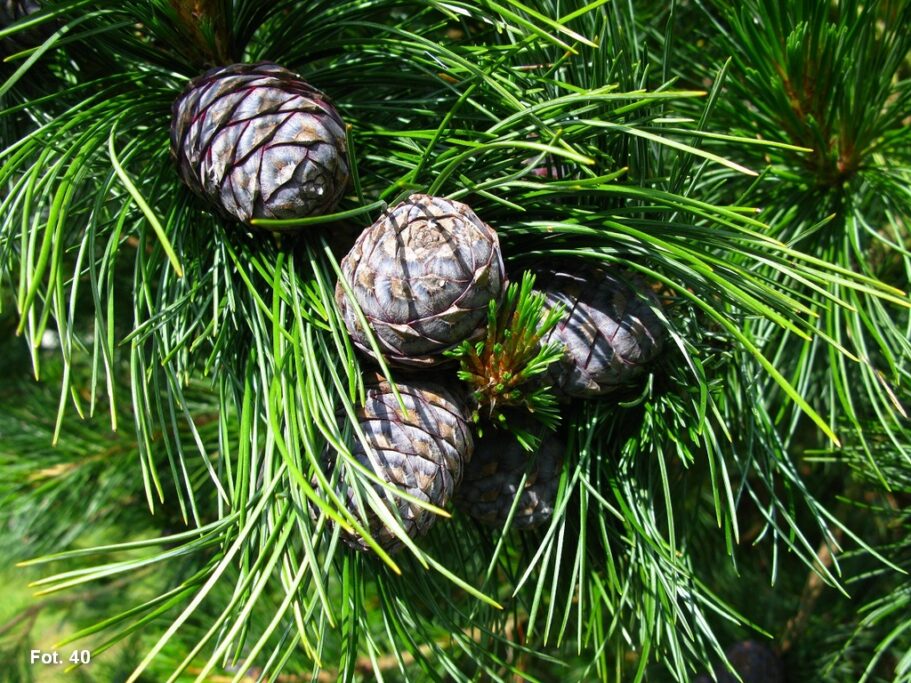- Supervisor: Jolanta Podlasiak, M.Sc.
- Others: Dr. Magdalena Bederska-Błaszczyk
- gardening technician Anna Gasek
- gardener Krzysztof Mróz
- General data: number of taxa about 1000.
- Area: 2.5 hectares
The collection includes:
- plant species under strict legal protection: 136, accounting for almost 50% of the total 296 placed in the regulation;
- species under partial protection: 63 out of 128 placed in the regulation (49%).
The collection also includes 306 species that are considered rare, endangered, threatened or extinct in Poland. The basis for determining the endangered status of a species are national and regional red lists and red books published since 1992.
Due to different habitat requirements, the plants in the collection are presented on several sites that vary in terms of light, soil and water conditions.
COLLECTION OF FLORA OF POLAND
Exposition of forest plants (Photo 1) is located in the bed along the avenue leading from the forest gate, above the ponds, the so-called forest bed, and in the eastern part of the Garden bordering Wczasowa Street, the "forest corner". Presented there are species of undergrowth plants of deciduous, coniferous and mixed forests growing in the lower part of Poland, as well as those associated with mountainous regions. Representatives of about a hundred species marked in this part of the collection may include: wolfsbane (Daphne mezereum), plants of this species often bloom as early as January, and in recent years in November, and bloom until March; snowdrop (Galanthus nivalis), whose flowering heralds the pre-winter; spring snowflake (Leucojum vernum) a perennial bulbous plant that blooms in March; two-leaved onion (Scilla bifolia) (Photo 2), an early spring geophyte, which is under partial species protection; Linden anemone (Anemone ×lipsiensis), a natural hybrid of wood anemone and yellow anemone; primrose (Primula elatior), spring peas (Lathyrus vernus), a spring perennial plant pollinated by bumblebees; fern (Polypodium vulgare); mountain arnica (Arnica montana); common fennel (Asarum europaeum) (Photo 3), an evergreen perennial with inconspicuous maroon-green flowers hidden under the leaves; East Carpathian pea (Lathyrus laevigatus) (Photo 4) with exceptional orange flowers that bloom in May; the golden-headed lily (Lilium martagon), whose flowers that appear in early June are similar to the Turkish turban.
Exposure of light-loving plants (Photo 5) is located at the end of the oak avenue leading from the forest gate, on a south-facing slope, and is the oldest part of the collection. This part of the collection is called the "teaching bed" or "sun bed." Here we will learn about xerothermic vegetation, associated with sunny slopes and limestone substrate, in Poland naturally occurring in the Nida Basin, Lublin Upland or Krakow-Czestochowa Upland, among others. This section presents selected plant species growing in thermophilous thickets, on the "flowery meadow steppe", in low flowery grasslands, ostrich and napia grasslands. Representatives of this type of plants are: black brome (Veratrum nigrum) with unusual maroon-colored flowers, gathered in showy inflorescences; red-blue recurrence (Lithospermum purpurocaeruleum) (photo 6), growing in Poland in only one locality, in the reserve "Bielinek nad Odrą"; ash-leaf diptam (Dictamnus albus) (Photo 7), a critically endangered species that secretes scorching essential oils; large-flowered anemone (Anemone sylvestris) with delicate, large white flowers; leafless scythe (Iris aphylla) (Photo 8), a strictly protected species and so scarce in the wild that it has been declared at risk of extinction; as well as the aster gavel (Aster amellus), Illyrian buttercup (Ranunculus illyricus), broad-leaved pea (Lathyrus latifolius) or several species of flax (Linum).
In close proximity to the display of light-loving plants, in a "teaching bed", the following were gathered plant species of coastal areas (Photo 9): sand sedge (Carex arenaria) often found on coastal dunes; common sandpiper (Leymus arenarius), a species included in pioneer communities found mainly on white dunes, is sometimes planted inland to fix inland dunes; seaside peas (Lathyrus japonicus subsp. maritimus) (Photo 10), the occurrence of which is limited to the Baltic coast, or the cup smaggard (Alyssum alyssoides) an insect- and self-pollinating annual plant found on inland dunes. Inland salt pans are represented by coastal milkvetch (Glaux maritima) (photo 11); coastal plantain (Plantago maritima) i feathered plantain (Plantago coronopus) (Photo 12), rarely found in moist salt meadows and pastures that tolerate grazing and trampling well.
Exposition of plants from the Beskids and Sudetes, as well as from the uplands and foothills (Photo 13) is located in the western part of the "teaching bed". Here you can see very rare plants, which in nature often grow in inaccessible places: deceptive feldspar (Saxifraga sponhemica) (Photo 14) occurring in Poland at the only site on Rogowa Kopa in the Table Mountains; tuber lily (Lilium bulbiferum) (Photo 15), whose Latin and Polish species name refers to the tubercles produced in the corners of leaves and bald carnation (Dianthus collinus) (Photo 16), a species extinct in Poland, previously reported from the Przemyśl area.
Exposure of extinct and rare species of field weeds is presented in the area of the "sun bed" by the stream. Its main idea is to show endangered and receding species accompanying crops. For the most part, these are archeophytes, i.e. species that arrived on Polish territory before the 15th century from the Mediterranean region and the Middle East. They got here together with the seed and perfectly established themselves in field communities. Their disappearance is associated with intensive changes in agriculture - the use of herbicides, the creation of monocultures, increased doses of fertilizer, increased mechanization, modern agrotechnology. These changes ultimately lead to a marked impoverishment of rural biodiversity, including field communities. Many weed species, previously common, have begun to disappear or become completely extinct. It is believed that nearly a hundred species of field weeds are threatened to varying degrees in our country. The positions of these species are mostly preserved in less developed areas, where extensive tillage still prevails, and where suitable habitat conditions exist, such as in the region of the presence of rendzina soils (from the Lublin Upland through Ponidzie, Miechowska Upland to Opole Silesia).
The exhibit currently features about 20 species. Among them are critically endangered taxa, included in the Polish Red Book of Plants: crested chytrid (Scandix pecten-veneris), yellow-flowered aspen (Ajuga chamaepitys) (Photo 17), field gouge (Misopates orontium) i flexion-extremity kixia (Kickxia spuria) (Photo 18). Among the other species, it is worth noting blue dustman (Anagallis foemina) (Photo 19), field nigella (Nigella arvensis) (Photo 20), knapweed (Illecebrum verticillatum), field agriculturist (Sherardia arvensis) and javelina kixia (Kickxia elatine).
Exposure of wetland plants can be viewed at the edge of the ravine near the Janówek villa. Here special attention should be paid to polish brew (Cochlearia polonica) (Photo 21). It is endemic to Poland, a biennial plant that reproduces mainly generatively. Plants of this species used to inhabit overhangs, small streams on sandy substrate, well-sunny places with clean water, low temperature and neutral pH. Progressive habitat degradation led to the complete drying out of natural sites, and thus to the extinction of the species. Today, we can see the Polish warbler only in botanical gardens or in substitute sites. Next to the warbler grows the Siberian scythe (Iris sibirica), one of the four species of blackbirds naturally occurring in Poland; the royal longhorn (Osmunda regalis), a majestic fern with leaves divided into a distinct-looking pubescent part and an upper brown fertile part, in Poland this species is in danger of extinction; horsetail (Equisetum variegatum), as well as blue multiflora (Polemonium caeruleum) (Photo 22), a glacial relic, or remnant in the flora of Poland from the period of glaciation; common quadrille (Paris guadrifolia) (Photo 23), the scientific name of the species may refer to the Latin word par, meaning evenly arranged, or to the mythological Paris. In the latter case, the fruit of the quadrilateral would symbolize the apple of discord, while the four leaves would symbolize the Trojan prince Paris and the goddesses arguing to be the most beautiful - Hera, Aphrodite and Athena; swordtail (Gladiolus palustris) (Photo 24), a critically endangered species, known from only two sites in Lower Silesia province; delicate woolly (Eriophorum gracile), a species considered endangered and under strict legal protection, as Poland is the southern limit of the species' range, and it has become extinct at many sites in recent years.
Collection of mountain plants opened to the public in 2003, plants of the Polish Carpathian Mountains are cultivated here, especially species found in the Tatra Mountains, Pieniny and Bieszczady. The plants of the Tatra Mountains are divided into two groups: those growing mainly on granite (calcium-free) substrates and those preferring substrates rich in calcium carbonate. The flora of the Pieniny is represented by species of meadow habitats and cliff grasslands, while the representatives of the Bieszczady range are the plants of the undergrowth of the lower alpine forests and of the Polonia.
Plants can be viewed by walking along paved roads at the foot of the mountains, or by climbing to the summits via the red trail.
Exposition of Tatra plant species It is located on the two highest hills called "Gawrysiowa Kopa" and "Powsinski Kopieniec". At the foot in early spring you can watch the crocuses (Crocus scepusiensis) (Photo 25), a strictly protected species since 1946, has been under partial protection since 2014; climbing on the dwarf pine is one of the few climbers in the Polish flora, the alpine clematis (Clematis alpina), legally protected in 1919, the first law protecting plant species, but never included under protection again. Hiking through the peaks, we can admire, among other things: eight-petal oak (Dryas octopetala) (Photo 26) a glacial relict (from the glacial period) in the Polish flora; edelweiss (Leontopodium alpinum) (Photo 27), protected by law since 1919, but almost completely exterminated in the Tatra Mountains in the 1930s; alpine creeper (Trollius altissimus), a high-mountain perennial that occurs in the mountain pine and mountain pasture floors; viviparous knotweed (Polygonum viviparum) is an example of adaptation to harsh climatic conditions, as the plant does not set seeds, but shortens the growing time, forming young plants in the inflorescence at once; on the rocks near the cascade grows a charming, small Shining carnation (Dianthus nitidus) (Photo 28), reported in Poland from the Pieniny Mountains, but not confirmed from that area after 1880 and now considered extinct. In the Tatra Mountains it grows just across the Polish border in Slovakia. Plants of this species planted in the exposition are from the Slovak part of the Tatra Mountains.
Exposition of naturally occurring plant species in the Pieniny area is located on the next two lower elevations, closest to the mountain house. Here grow, among other things, the uvula (Phillitis scolopendrium), the only fern in Poland with undivided leaves that persists through the winter, but dies back in the spring; Zawadzki's chrysanthemum (Dendranthema zawadzkii) (Photo 29), one of the icons of the peculiarities of the Pieniny flora, a geographic relic separated from its dense range of occurrence by about a thousand kilometers; the median tawula (Spiraea media), the localities of this species are found only in the Pieniny and Bieszczady Mountains, and the number of individuals is small therefore the species is considered vulnerable to extinction; crossbill gentian (Gentiana cruciata) one of eight species of gentian growing in the country, associated with sunny areas with calcareous substrates; rock tarragon (Alyssum saxatile) (Photo 30) in Poland found only on limestone rocks of the Pieniny Mountains, otherwise in analogous habitats of southeastern Europe; Sabine juniper (Juniperus sabina) (Photo 31) is another peculiar representative of the Pieniny vegetation, it naturally grows on limestone rocks with a southeastern exposure, on two sites, on Facimiech and Piecki rocks, these sites have the character of a relic from the pre-glacial period; pszonak pieniński (Erysimum pieninicum) (Photo 32) is an endemic of Poland occurring in four sites in the Polish part of Pieniny Właściwe and Maly Pieniny.
Exposition of plants representing the flora of the Bieszczady Mountains (Photo 33) is located on a gently shaped slope with an eastern sunny exposure. Planted on the grassy slope, among others, are many species exclusively associated with the Eastern Carpathians, of which the Polish Bieszczady Mountains are a part. Rock carnation (Dianthus cartusianorum subsp. saxigenus) (Photo 34) is an endemic subspecies found only on the rocks in the highest parts of the Poloniny Mountains in the Krzemień, Kopa Bukowskiej and Bukowy Brod groups, and is threatened with extinction. Other plant species found on Bieszczady rocks: Carpathian stickleback (Silene dubia), dacka sedge (Carex dacica), Austrian oriole (Euphorbia austriaca). The following have their habitats in the meadow communities and in the grasslands: the Kotschy's cornflower (Centaurea kotschyana), in Poland it grows only in the Western Bieszczady Mountains, where the western limit of the species' range runs; clustered carnation (Dianthus compactus), in Poland associated only with the Bieszczady range; Moldavian toadstool (Aconitum moldavicum), a sub-endemic of the Carpathians (it has sparse stands outside the Carpathians), the species has been under strict legal protection since 1957. In addition to those highlighted, it is also worth noting other species of plants associated with the Polonnas: alpine creeper (Trollius altissimus), soft-haired cornflower (Centaurea mollis), Klusjus's baldrootrootroot weed (Tanacetum corymbosum subsp. clusii). In the beech forests of the lower regale, spring geophytes appear after the snows come down: Carpathian spring snowflake (Leucojum vernum subsp. carpaticum) (Photo 35) distinguished from the typical species by the more frequent appearance of two flowers on the shoot; Krain's lulecznica (Scopolia carniolica), in Poland the sites of this species are concentrated mainly in the Bieszczady Mountains, and the Pieniny Mountains are the western limit of its range; in summer in the Bieszczady forests it blooms smotrava grande (Telekia speciosa) (Photo 36) found throughout Poland, but it is likely that the natural sites of this species are located only in the Bieszczady Mountains; elsewhere it was cultivated and feral.
In close proximity to the exhibition of plants representing the flora of the Bieszczady Mountains is a wooden house, which serves as an information point about the collection. In the showcases inside you will find basic information about the Polish mountains, general assumptions and data about the collection, as well as brief information about common, protected and endangered mountain plants, which are relicts or endemics in the Tatras, Pieniny and Bieszczady.
The flora collection of Poland is surrounded to the west and south by areas with mountain pine (Pinus mugo) called mountain pine (Photo 37) - 2-3 year old plants were brought to the Garden from the nurseries of the Tatra National Park in 1979. After almost 40 years of cultivation, many differences can be observed in individual specimens, as well as in the population as a whole. Plants growing in the Garden are very large, spreading (Photo 38) or look like trees with a straight stiff trunk, which is perhaps due to the low snow cover in lowland conditions. Looking more closely at the individual plants, one will see that despite the same age, some grow several meters up, while others barely grow up to 2 meters. Recent years with minimal snow cover, modest rainfall, and low humidity have resulted in the mass death of mountain pine shoots. Since 2023, diseased or dead plants have been successively removed, and in their place are planted new cultivars, mountain pine with little growth and more adapted to garden conditions. A large area of the collection is occupied by limber pine (Pinus cembra) (Photo 39) brought to the Garden in 1986 in the form of scions (pieces of shoots), and here it was grafted onto rootstocks from Scots pine. This procedure allowed the plants to enter the cone-forming period more quickly (photo 40), which in ungrafted plants occurs only after about 60 years. Unfortunately, after a longer period of observation, it turned out that grafting a five-needle limber pine onto a two-needle Scots pine causes incompatibility in the vascular bundles and, as a consequence, sometimes leads to the death of the plants.
In 2019, a heathland was created on a slope below the exposure of naturally occurring plant species in the Pieniny area. Common heather (Calluna vulgaris), bearberry (Arctostaphyllos uva-ursi), common juniper (Juniperus communis) and dotted carnation (Dianthus deltoides).
Visitors are acquainted with the exact plan of the Mountain Plant Collection by information boards placed near the roads leading to the exposition.
The construction of the Collection of Mountain Plants of the Flora of Poland was made possible thanks to a grant from the National Fund for Environmental Protection and Water Management for the investment.
Tired of mountain hiking, we can relax listening to the sound of the stream or rest on benches overlooking the surroundings.
Photo authors
W. Gavrys
A. Gasek
M. Niemczyk

